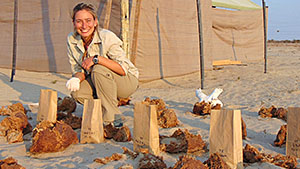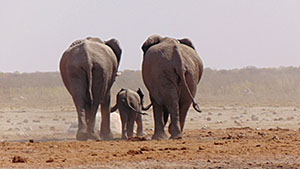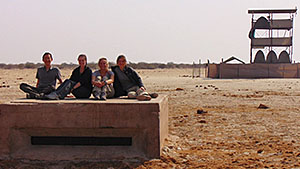Jaquelyn Lauletta - Namibia



Walking among Elephants
This last summer, I had the pleasure of conducting a STAR project in Namibia studying stress-hormones of free-roaming African elephants. I spent five weeks in Etosha National Park, Namibia performing my field work and one week at the San Diego Zoo Institute for Conservation Research extracting and measuring the hormones in the laboratory. This was an amazing experience and a phenomenal way to spend my last summer in veterinary school!
I was blessed with the opportunity to take part in such unique, exciting wildlife research with the help of Dr. Patricia Conrad. Dr. Conrad, my STAR mentor, connected me with a leading scientist in the field of elephant behavior from Stanford University, Dr. Caitlin O’Connell. For 15 years now, Dr. O’Connell has studied free-roaming African elephants in Etosha National Park and has written countless scientific publications, books, and articles about elephant behavior, ecology, conservation, and communication. Her and I designed a field experiment to study cortisol degradation in wild elephant fecal samples in the hot, dry desert of sub-Saharan Africa.
For five weeks, I lived in Etosha National Park, Namibia at the Mushara research station working with Dr. O’Connell and other field assistants, including three undergraduate researchers. During the span of the field season, we all worked together in conducting several research projects, many of which are on-going studies that Dr. O’Connell has performed for many years. Every year, Dr. O’Connell has studied the social interactions of over 150 known elephant bulls and approximately 15 different elephant family groups. In addition to my cortisol degradation study, I got to take part in many exciting research studies: studying elephant Strongyle parasite load in fresh fecal samples, using acoustics and night vision to study elephant bull communication and behavior, studying mother and calf interactions associated with different hierarchal status, and herd and bull dominance interactions and general elephant behavior. I also helped create a computerized database to help catalogue the numerous physical characteristics used to identify the hundreds of known elephants that frequently visit the research site.
Living at the Mushara field site was a remarkable yet challenging experience. Mushara waterhole is located in the heart of the northeastern corner of Etosha National Park and is closed off to the public. Hundreds of elephants, among other wildlife, visit the waterhole throughout the dry season. For the entire month, I lived with 9 other field assistants and researchers in a 10 by 10 meter camp with a three-story platform tower. The field camp is completely isolated and run entirely on solar energy. We all slept in shared tents in the tower, with front-row views of the waterhole, and rotated through the various camp and research duties. The camp has no plumbing or running water and is enclosed in a boma fence and an electric fence that is turned on at night. I felt completely immersed in my wild surroundings and was in awe every night by the unbelievable night sky and the lively sounds of the African wild.
Upon returning to the United States, I spent my last week of the summer working in the laboratory at the San Diego Institute for Conservation Medicine extracting cortisol from the fecal samples I collected in Namibia and performing immunofluorescent assays to measure the levels of hormones present in each sample.
This was an incredible international research experience and it will always be one of my most memorable, extraordinary summers of my life. I could not have done it without the help of the International Summer Externship Travel Fund, STAR, and my fantastic mentors.
